Unstressed by the Sea : El Morro’s Merry Mixture Includes Pensioners and Millionaires
Set along a peaceful stretch of coast just south of here, the El Morro Beach Mobilehome Park could suck the stress out of Los Angeles.
Every summer, a handful of the Southland’s hassled and harried seek refuge in this slice of Bohemia off Coast Highway, where the cocktail hour starts early, everyone seems to know each other, and getting into a pair of shorts and a T-shirt is the great equalizer.
“People come here and strip off their costumes and pretensions,” said Joann Hyslop, a park resident who is working on a video history of El Morro. “All barriers drop no matter how many cellular phones you have. Millionaires mix with those on Social Security. It is their common ground.”
The melting pot apparently has existed since 1948, when the grounds of Tyron’s Camp were turned into a trailer park with 47 spaces. The land beneath the Spartan, Airstream and Flamingo coaches was owned by the Irvine Co. before it was sold to the state for Crystal Cove State Park years later.
Today, there are about 295 mobile homes that start at the beach and wend their way up a hill next to El Moro Canyon. About a third of the residents live there year-round; the rest on weekends or in the summer.
Among the habitues are doctors, lawyers, teachers, retirees, business people and a passel of top executives from the Irvine Co., the county’s largest landholder. There are local politicians, such as Irvine Mayor Sally Anne Sheridan, and the infamous, including developer Bill L. Walters, a figure in the national savings and loan scandal.
Walters told a congressional committee in June, 1990, that he was broke after defaulting on nearly $100 million in loans obtained from Denver-based Silverado Thrift & Loan with the help of Neil Bush, the President’s son.
Residents say El Morro can be divided geographically into what might be considered three different neighborhoods, each with its own distinctive atmosphere--the beach, the valley, and the terrace.
The “brie and Chablis” types live along the beach side of Coast Highway. Their mobile homes, some with second stories, observation decks and colorful pennants, sit on wooden piers above the sand. Parked in front are BMWs, Cadillacs and Mercedes Benzes. A glass of wine is de rigueur for a stroll on the sand.
“I call them the stemware set,” said Russ Hyslop, Joann’s husband.
The Hyslops, whose relatives have been coming to the park for years, live in the “Valley,” which is separated from the beach set by Coast Highway. Also known as Skunk Hollow, it is the park’s low-rent district, but the residents make up for it with plenty of reasons to have a party.
“I guess we are the Mennen Skin Bracer types,” said Donald Sheridan, a real estate agent who is married to Mayor Sheridan. “We party hard. . . . No one is here to do deals.”
The park’s more conservative element lives up the hill in “The Terrace.” It is the land of the double-wides and home to most of El Morro’s permanent residents. Each lot has a panoramic view of the ocean.
The homes throughout the park range from aluminum boxes worth about $65,000 to opulent $400,000 quarters with views of the coast comparable to any multimillion-dollar mansion in nearby Irvine Cove.
“You wouldn’t believe it. You can’t even tell some of these places are mobile homes,” said Jack Morrisseau, the park’s general manager.
In many cases mobile homes are just the foundation, with living rooms, bedrooms, modern kitchens, stained glass windows and sun decks added. Kenny and Seanne Tonkovich’s 1953 Spartan, for example, with its aluminum sides and veneer paneling, represents just a quarter of their home. Neighbors have dubbed it “the Taj Mahal,” although it has only 540 square feet.
The Tonkoviches’ permanent residence is a 2,500-square-foot house in the Woodbridge section of Irvine.
Two volleyball tournaments sponsored by the homeowners association are held on the Fourth of July and Labor Day, which signal the unofficial start and end of summer. There are bridge and backgammon competitions, potluck dinners and barbecues.
“There are no formal events,” said Sally Anne Sheridan, who owns a 1957 Flamingo trailer. “That’s what we all want to get a way from anyway. Its’ not a pretentious place. It’s where I can be myself and be with my friends.”
The attractiveness of it all has made El Morro a hard place to give up. Few people leave, and many of the trailers have been handed down from generation to generation.
But the future does not look good. Residents will be required to pack up and leave by Dec. 31, 1999, when the current owner’s lease with the state expires. Unless a new agreement is reached, the park will be closed permanently.
The closure would “destroy a rather unique community,” said Russ Hyslop. “It’s really a time warp here. I don’t really want to think about it too much.”
More to Read
Inside the business of entertainment
The Wide Shot brings you news, analysis and insights on everything from streaming wars to production — and what it all means for the future.
You may occasionally receive promotional content from the Los Angeles Times.







